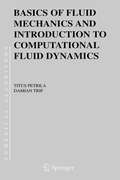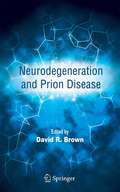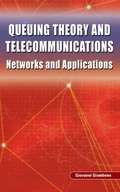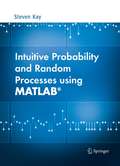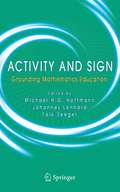- Table View
- List View
A Posteriori Error Analysis Via Duality Theory: With Applications in Modeling and Numerical Approximations (Advances in Mechanics and Mathematics #8)
by Weimin HanThis work provides a posteriori error analysis for mathematical idealizations in modeling boundary value problems, especially those arising in mechanical applications, and for numerical approximations of numerous nonlinear var- tional problems. An error estimate is called a posteriori if the computed solution is used in assessing its accuracy. A posteriori error estimation is central to m- suring, controlling and minimizing errors in modeling and numerical appr- imations. In this book, the main mathematical tool for the developments of a posteriori error estimates is the duality theory of convex analysis, documented in the well-known book by Ekeland and Temam ([49]). The duality theory has been found useful in mathematical programming, mechanics, numerical analysis, etc. The book is divided into six chapters. The first chapter reviews some basic notions and results from functional analysis, boundary value problems, elliptic variational inequalities, and finite element approximations. The most relevant part of the duality theory and convex analysis is briefly reviewed in Chapter 2.
Shortest Connectivity: An Introduction with Applications in Phylogeny (Combinatorial Optimization #17)
by Dietmar CieslikThe aim in this graduate level text is to outline the key mathematical concepts that underpin these important questions in applied mathematics. These concepts involve discrete mathematics (particularly graph theory), optimization, computer science, and several ideas in biology.
Optimal Control Models in Finance: A New Computational Approach (Applied Optimization #95)
by Ping Chen Sardar M. IslamThis book reports initial efforts in providing some useful extensions in - nancial modeling; further work is necessary to complete the research agenda. The demonstrated extensions in this book in the computation and modeling of optimal control in finance have shown the need and potential for further areas of study in financial modeling. Potentials are in both the mathematical structure and computational aspects of dynamic optimization. There are needs for more organized and coordinated computational approaches. These ext- sions will make dynamic financial optimization models relatively more stable for applications to academic and practical exercises in the areas of financial optimization, forecasting, planning and optimal social choice. This book will be useful to graduate students and academics in finance, mathematical economics, operations research and computer science. Prof- sional practitioners in the above areas will find the book interesting and inf- mative. The authors thank Professor B.D. Craven for providing extensive guidance and assistance in undertaking this research. This work owes significantly to him, which will be evident throughout the whole book. The differential eq- tion solver “nqq” used in this book was first developed by Professor Craven. Editorial assistance provided by Matthew Clarke, Margarita Kumnick and Tom Lun is also highly appreciated. Ping Chen also wants to thank her parents for their constant support and love during the past four years.
Supply Chain Optimisation: Product/Process Design, Facility Location and Flow Control (Applied Optimization #94)
by Alexandre Dolgui Jerzy Soldek Oleg ZaikinThis volume collects recent results in supply chain optimisation. It presents new approaches and methods based on operations research, artificial intelligence and advanced computing techniques for design of production systems, supply and inventory management, production planning and scheduling, location, transportation and logistics, and simulation in supply flow optimisation. The text presents a wide spectrum of optimisation problems taking into account supply chain paradigms, which are pivotal to improving productivity.
Functions of a-Bounded Type in the Half-Plane (Advances in Complex Analysis and Its Applications #4)
by A.M. JerbashianThis book is related to the theory of functions of a-bounded type in the ha- plane of the complex plane. I constructed this theory by application of the Li- ville integro-differentiation. To some extent, it is similar to M.M.Djrbashian's factorization theory of the classes Na of functions of a-bounded type in the disc, as much as the well known results on different classes and spaces of regular functions in the half-plane are similar to those in the disc. Besides, the book contains improvements of several results such as the Phragmen-Lindelof Principle and Nevanlinna Factorization in the Half-Plane and offers a new, equivalent definition of the classical Hardy spaces in the half-plane. The last chapter of the book presents author's united work with G.M. Gubreev (Odessa). It gives an application of both a-theories in the disc and in the half-plane in the spectral theory of linear operators. This is a solution of a problem repeatedly stated by M.G.Krein and being of special interest for a long time. The book is proposed for a wide range of readers. Some of its parts are comprehensible for graduate students, while the book in the whole is intended for young researchers and qualified specialists in the field.
Generalized Convexity, Generalized Monotonicity and Applications: Proceedings of the 7th International Symposium on Generalized Convexity and Generalized Monotonicity (Nonconvex Optimization and Its Applications #77)
by Andrew Eberhard Nicolas Hadjisavvas D. T. LucIn recent years there is a growing interest in generalized convex fu- tions and generalized monotone mappings among the researchers of - plied mathematics and other sciences. This is due to the fact that mathematical models with these functions are more suitable to describe problems of the real world than models using conventional convex and monotone functions. Generalized convexity and monotonicity are now considered as an independent branch of applied mathematics with a wide range of applications in mechanics, economics, engineering, finance and many others. The present volume contains 20 full length papers which reflect c- rent theoretical studies of generalized convexity and monotonicity, and numerous applications in optimization, variational inequalities, equil- rium problems etc. All these papers were refereed and carefully selected from invited talks and contributed talks that were presented at the 7th International Symposium on Generalized Convexity/Monotonicity held in Hanoi, Vietnam, August 27-31, 2002. This series of Symposia is or- nized by the Working Group on Generalized Convexity (WGGC) every 3 years and aims to promote and disseminate research on the field. The WGGC (http://www.genconv.org) consists of more than 300 researchers coming from 36 countries.
Metaheuristic Optimization via Memory and Evolution: Tabu Search and Scatter Search (Operations Research/Computer Science Interfaces Series #30)
by Bahram Alidaee César RegoTabu Search (TS) and, more recently, Scatter Search (SS) have proved highly effective in solving a wide range of optimization problems, and have had a variety of applications in industry, science, and government. The goal of Metaheuristic Optimization via Memory and Evolution: Tabu Search and Scatter Search is to report original research on algorithms and applications of tabu search, scatter search or both, as well as variations and extensions having "adaptive memory programming" as a primary focus. Individual chapters identify useful new implementations or new ways to integrate and apply the principles of TS and SS, or that prove new theoretical results, or describe the successful application of these methods to real world problems.
Handbook of Combinatorial Optimization: Supplement Volume B
by Ding-Zhu Du Panos M. PardalosThis is a supplementary volume to the major three-volume Handbook of Combinatorial Optimization set. It can also be regarded as a stand-alone volume presenting chapters dealing with various aspects of the subject in a self-contained way.
Basics of Fluid Mechanics and Introduction to Computational Fluid Dynamics (Numerical Methods and Algorithms #3)
by Titus Petrila Damian TrifThe present book – through the topics and the problems approach – aims at filling a gap, a real need in our literature concerning CFD (Computational Fluid Dynamics). Our presentation results from a large documentation and focuses on reviewing the present day most important numerical and computational methods in CFD. Many theoreticians and experts in the field have expressed their - terest in and need for such an enterprise. This was the motivation for carrying out our study and writing this book. It contains an important systematic collection of numerical working instruments in Fluid Dyn- ics. Our current approach to CFD started ten years ago when the Univ- sity of Paris XI suggested a collaboration in the field of spectral methods for fluid dynamics. Soon after – preeminently studying the numerical approaches to Navier–Stokes nonlinearities – we completed a number of research projects which we presented at the most important inter- tional conferences in the field, to gratifying appreciation. An important qualitative step in our work was provided by the dev- opment of a computational basis and by access to a number of expert softwares. This fact allowed us to generate effective working programs for most of the problems and examples presented in the book, an - pect which was not taken into account in most similar studies that have already appeared all over the world.
Neurodegeneration and Prion Disease
by David R. BrownThis is the first and only book on the subject of prions to cover the cause of cell death in the disease. It covers the full range of competing theories on the subject, from broad description and basic points up to the final details of the basic science.
Real-Time Management of Resource Allocation Systems: A Discrete Event Systems Approach (International Series in Operations Research & Management Science #79)
by Spyros A. ReveliotisReal-Time Management of Resource Allocation Systems focuses on the problem of managing the resource allocation taking place within the operational context of many contemporary technological applications, including flexibly automated production systems, automated railway and/or monorail transportation systems, electronic workflow management systems, and business transaction supporting systems. A distinct trait of all these applications is that they limit the role of the human element to remote high-level supervision, while placing the burden of the real-time monitoring and coordination of the ongoing activity upon a computerized control system. Hence, any applicable control paradigm must address not only the issues of throughput maximization, work-in-process inventory reduction, and delay and cost minimization, that have been the typical concerns for past studies on resource allocation, but it must also guarantee the operational correctness and the behavioral consistency of the underlying automated system. The resulting problem is rather novel for the developers of these systems, since, in the past, many of its facets were left to the jurisdiction of the present human intelligence. It is also complex, due to the high levels of choice – otherwise known as flexibility – inherent in the operation of these environments.
New Teacher Identity and Regulative Government: The Discursive Formation of Primary Mathematics Teacher Education (Mathematics Teacher Education #2)
by Tony Brown Olwen McNamaraThis book seeks to address the question of how the task of teaching mathematics to young children might be better understood. But rather than starting out with a conception of mathematics derived from the many histories mathematics might claim as its own we centre the analysis instead within the social practices that surround the teaching of the subject to children aged four to eleven in English primary schools today. That is, we do not commence with an a priori conception of mathematics and see what people are saying about it. Rather, we start from what people are saying and see where this points. We probe how the desires of society have manifested themselves in a societal decision to teach mathematics and how this decision now shapes that which is called "mathematics". We focus on the operation of the noun "mathematics" and verb "mathematical" and consider how the meanings of these terms derive from the social domain in which they are being used. This extends and develops a conception of how language intervenes in the task of mathematics education presented elsewhere (Brown, 2001). In this present book however, we have a particular focus on trainee and newly qualified teachers, with a view to pinpointing how this conception of mathematics manifests itself in their evolving practices. We question how such teachers with many years of experience as a pupil in school might now re-orient themselves towards the demands of teaching mathematics in schools.
Queuing Theory and Telecommunications: Networks and Applications
by Giovanni GiambeneCovering both fundamental methods and practical applications used for telecommunication network analysis and design Integrating quantative and qualitative treatment of the new topics in networking such as MPLS, access protocols, among others Targeted at engineers and graduate students majoring in networking
Modeling Performance Measurement: Applications and Implementation Issues in DEA
by Wade D. Cook Joe ZhuThis volume addresses advanced DEA methodology and techniques developed for modeling unique new performance evaluation issues. Many numerical examples, real management cases and verbal descriptions make it very valuable for researchers and practitioners.
Nonlinear Optimization with Financial Applications
by Michael Bartholomew-BiggsThis instructive book introduces the key ideas behind practical nonlinear optimization, accompanied by computational examples and supporting software. It combines computational finance with an important class of numerical techniques.
Intuitive Probability and Random Processes using MATLAB®
by Steven KayIntuitive Probability and Random Processes using MATLAB® is an introduction to probability and random processes that merges theory with practice. Based on the author’s belief that only "hands-on" experience with the material can promote intuitive understanding, the approach is to motivate the need for theory using MATLAB examples, followed by theory and analysis, and finally descriptions of "real-world" examples to acquaint the reader with a wide variety of applications. The latter is intended to answer the usual question "Why do we have to study this?" Other salient features are: *heavy reliance on computer simulation for illustration and student exercises *the incorporation of MATLAB programs and code segments *discussion of discrete random variables followed by continuous random variables to minimize confusion *summary sections at the beginning of each chapter *in-line equation explanations *warnings on common errors and pitfalls *over 750 problems designed to help the reader assimilate and extend the concepts Intuitive Probability and Random Processes using MATLAB® is intended for undergraduate and first-year graduate students in engineering. The practicing engineer as well as others having the appropriate mathematical background will also benefit from this book. About the Author Steven M. Kay is a Professor of Electrical Engineering at the University of Rhode Island and a leading expert in signal processing. He has received the Education Award "for outstanding contributions in education and in writing scholarly books and texts..." from the IEEE Signal Processing society and has been listed as among the 250 most cited researchers in the world in engineering.
Ordered Sets (Advances in Mathematics #7)
by Egbert HarzheimThis detailed textbook presents a great deal of material on ordered sets not previously published in the still rather limited textbook literature. It should be suitable as a text for a course on order theory.
Theory and Applications of Special Functions: A Volume Dedicated to Mizan Rahman (Developments in Mathematics #13)
by Mourad E. H. Ismail Erik KoelinkA collection of articles on various aspects of q-series and special functions dedicated to Mizan Rahman. It also includes an article by Askey, Ismail, and Koelink on Rahman’s mathematical contributions and how they influenced the recent upsurge in the subject.
The Construction of New Mathematical Knowledge in Classroom Interaction: An Epistemological Perspective (Mathematics Education Library #38)
by Heinz SteinbringMathematics is generally considered as the only science where knowledge is uni form, universal, and free from contradictions. „Mathematics is a social product - a 'net of norms', as Wittgenstein writes. In contrast to other institutions - traffic rules, legal systems or table manners -, which are often internally contradictory and are hardly ever unrestrictedly accepted, mathematics is distinguished by coherence and consensus. Although mathematics is presumably the discipline, which is the most differentiated internally, the corpus of mathematical knowledge constitutes a coher ent whole. The consistency of mathematics cannot be proved, yet, so far, no contra dictions were found that would question the uniformity of mathematics" (Heintz, 2000, p. 11). The coherence of mathematical knowledge is closely related to the kind of pro fessional communication that research mathematicians hold about mathematical knowledge. In an extensive study, Bettina Heintz (Heintz 2000) proposed that the historical development of formal mathematical proof was, in fact, a means of estab lishing a communicable „code of conduct" which helped mathematicians make themselves understood in relation to the truth of mathematical statements in a co ordinated and unequivocal way.
Optimization and Control with Applications (Applied Optimization #96)
by Liqun Qi Kok Lay Teo Xiao Qi YangA collection of 28 refereed papers grouped according to four broad topics: duality and optimality conditions, optimization algorithms, optimal control, and variational inequality and equilibrium problems. Suitable for researchers, practitioners and postgrads.
Optimal Control of Distributed Systems with Conjugation Conditions (Nonconvex Optimization and Its Applications #75)
by Ivan V. Sergienko Vasyl S. DeinekaAt present, in order to resolve problems of ecology and to save mineral resources for future population generations, it is quite necessary to know how to maintain nature arrangement in an efficient way. It is possible to achieve a rational nature arrangement when analyzing solutions to problems concerned with optimal control of distributed systems and with optimization of modes in which main ground medium processes are functioning (motion of liquids, generation of temperature fields, mechanical deformation of multicomponent media). Such analysis becomes even more difficult because of heterogeneity of the region that is closest to the Earth surface, and thin inclusions/cracks in it exert their essential influence onto a state and development of the mentioned processes, especially in the cases of mining. Many researchers, for instance, A.N. Tikhonov - A.A. Samarsky [121], L. Luckner - W.M. Shestakow [65], Tien-Mo Shih, K.L. Johnson [47], E. Sanchez-Palencia [94] and others stress that it is necessary to consider how thin inclusions/cracks exert their influences onto development of these processes, while such inclusions differ in characteristics from main media to a considerable extent (moisture permeability, permeability to heat, bulk density or shear strength may be mentioned). Xll An influence exerted from thin interlayers onto examined processes is taken into account sufficiently adequately by means of various constraints, namely, by the conjugation conditions [4, 8, 10, 15, 17-20, 22-26, 38, 44, 47, 52, 53, 68, 76, 77, 81, 83, 84, 90, 95, 96-100, 112-114, 117, 123].
Humans-with-Media and the Reorganization of Mathematical Thinking: Information and Communication Technologies, Modeling, Visualization and Experimentation (Mathematics Education Library #39)
by Marcelo C. Borba Monica E. VillarrealThis book offers a new conceptual framework for reflecting on the role of information and communication technology in mathematics education. Discussion focuses on how computers, writing and oral discourse transform education at an epistemological as well as a political level. Building on examples, research and theory, the authors propose that knowledge is not constructed solely by humans, but by collectives of humans and technologies of intelligence.
Activity and Sign: Grounding Mathematics Education
by Michael H. G. Hoffmann Johannes Lenhard Falk SeegerThe advancement of a scientific discipline depends not only on the "big heroes" of a discipline, but also on a community’s ability to reflect on what has been done in the past and what should be done in the future. This volume combines perspectives on both. It celebrates the merits of Michael Otte as one of the most important founding fathers of mathematics education by bringing together all the new and fascinating perspectives created through his career as a bridge builder in the field of interdisciplinary research and cooperation. The perspectives elaborated here are for the greatest part motivated by the impressing variety of Otte’s thoughts; however, the idea is not to look back, but to find out where the research agenda might lead us in the future. This volume provides new sources of knowledge based on Michael Otte’s fundamental insight that understanding the problems of mathematics education – how to teach, how to learn, how to communicate, how to do, and how to represent mathematics – depends on means, mainly philosophical and semiotic, that have to be created first of all, and to be reflected from the perspectives of a multitude of diverse disciplines.
The Schur Complement and Its Applications (Numerical Methods and Algorithms #4)
by Fuzhen ZhangThis book describes the Schur complement as a rich and basic tool in mathematical research and applications and discusses many significant results that illustrate its power and fertility. Coverage includes historical development, basic properties, eigenvalue and singular value inequalities, matrix inequalities in both finite and infinite dimensional settings, closure properties, and applications in statistics, probability, and numerical analysis.








